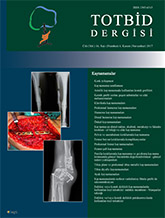
Reconstruction of large diaphyseal bone defects is the biggest problem in the recovery of the extremity regardless of the etiology of bone loss. The most well-known and widely used procedures currently accepted for solving this problem are vascularized bone transfer, Ilizarovdistraction technique, and induced membrane (IM) technique. This technique, developed by Masquelet et al. in 1986, is an accepted, simple, and effective method of reconstruction of bone defects. Masquelet et al. initially described this technique only for bone loss due to infection non-union, but over time this method has begun to be used in many bone defect reconstructions for whatever reason. Technically, this method, which is not too complicated and does not require high surgical skills, must be followed strictly for its success. Literature review suggests that IM-Masquelet technique is a reliable method in the treatment of septic non-union, but variable complication and union times are reported. Undoubtedly, this may be due to the fact that septic non-union cases are located in a wide range, but surgical technique details should also be taken into consideration. Despite the current evidence, further research is needed to clarify the use of the IM technique and to improve the clinical outcomes.